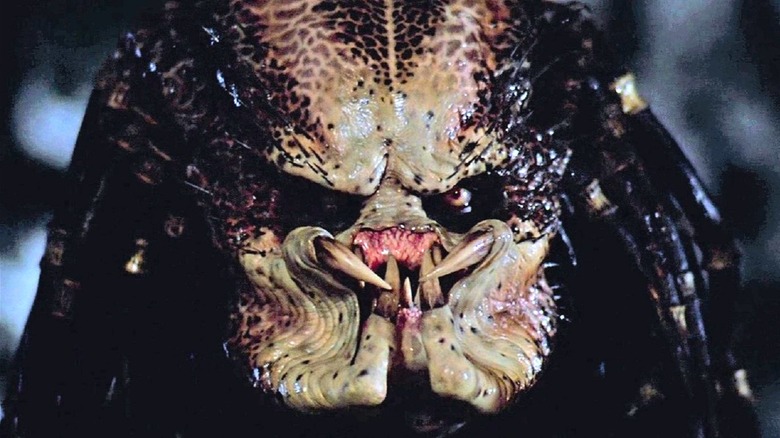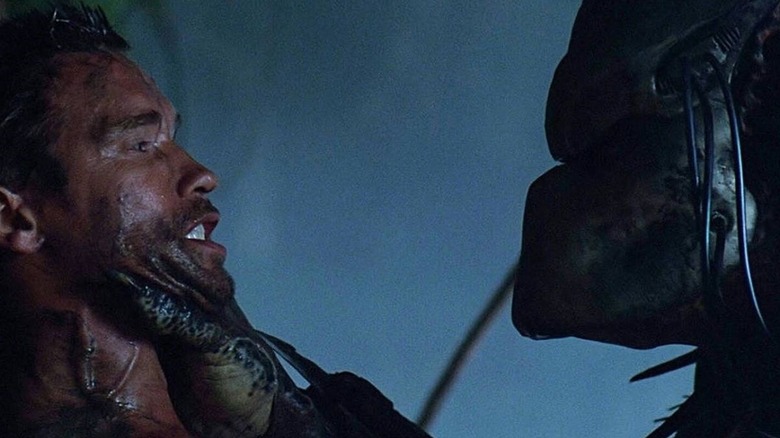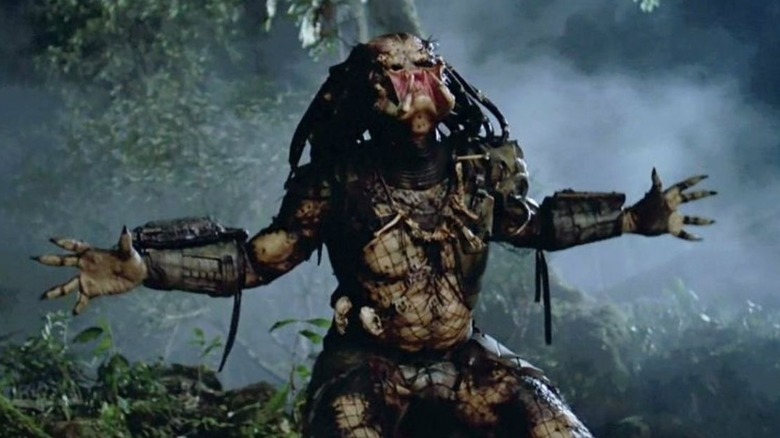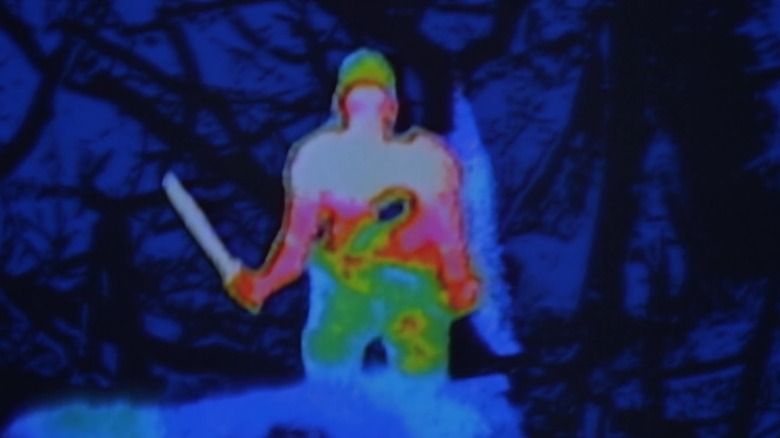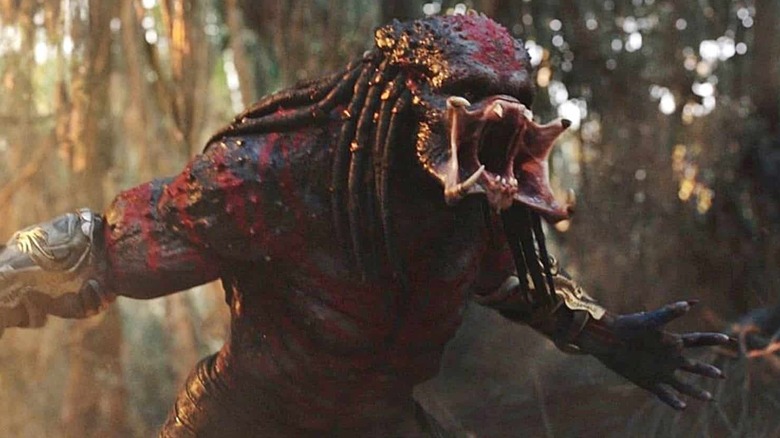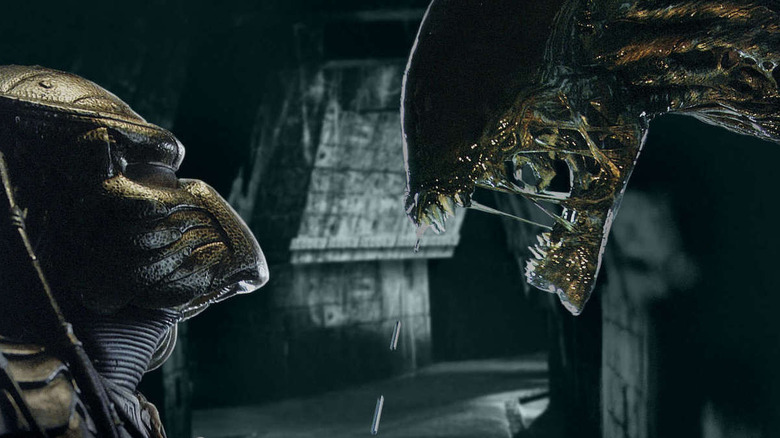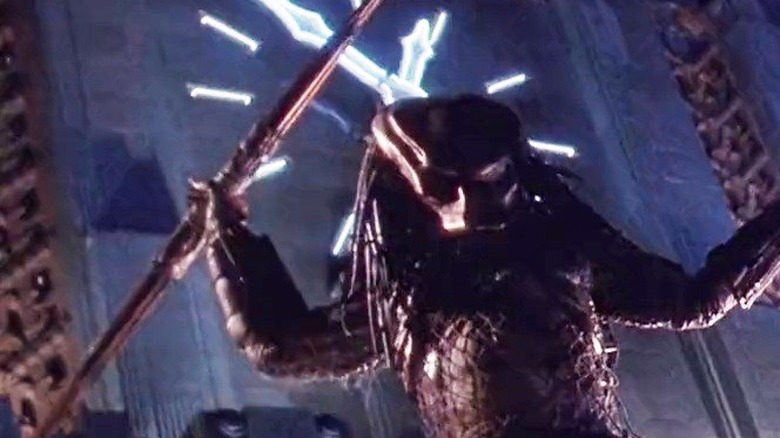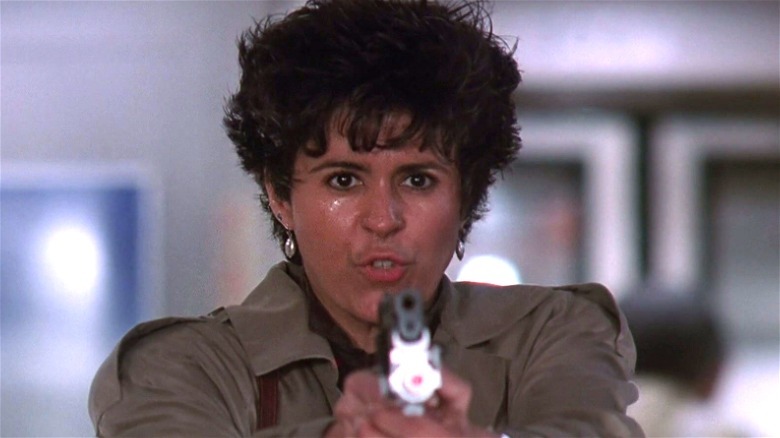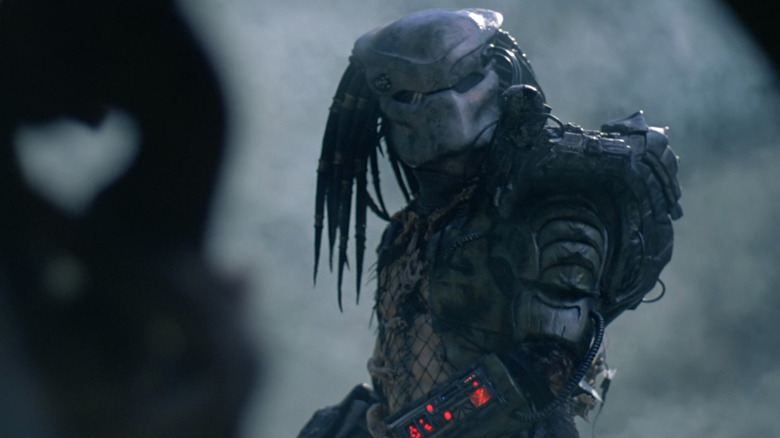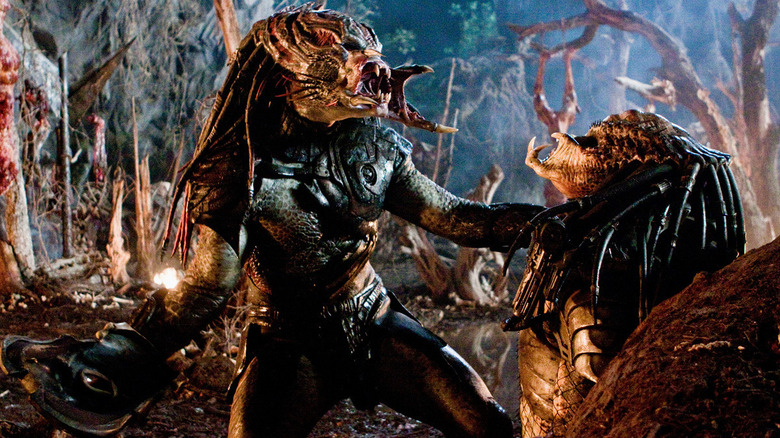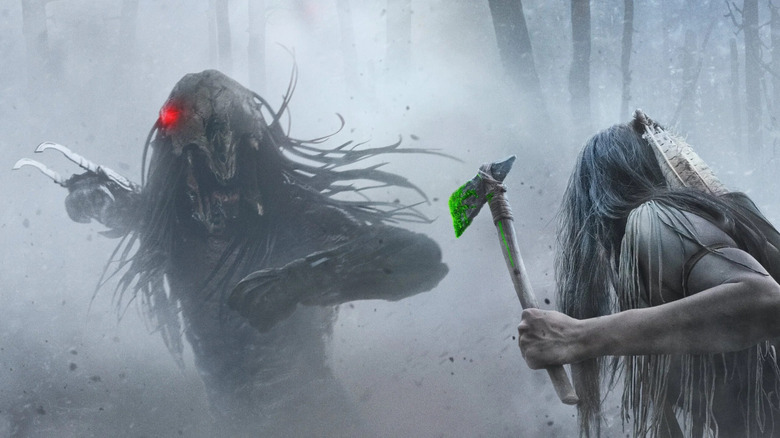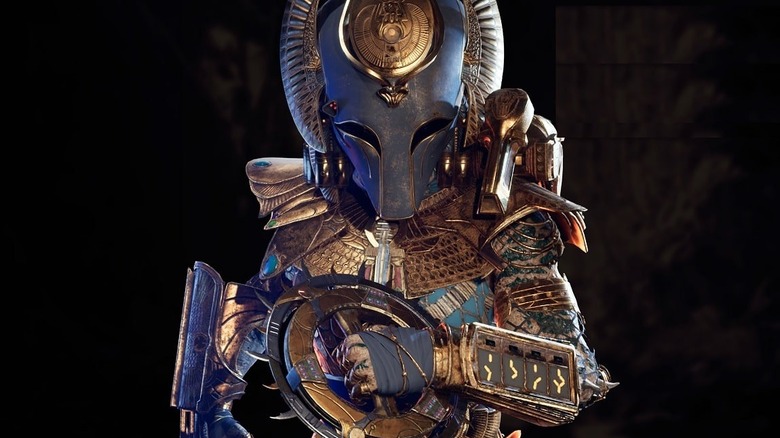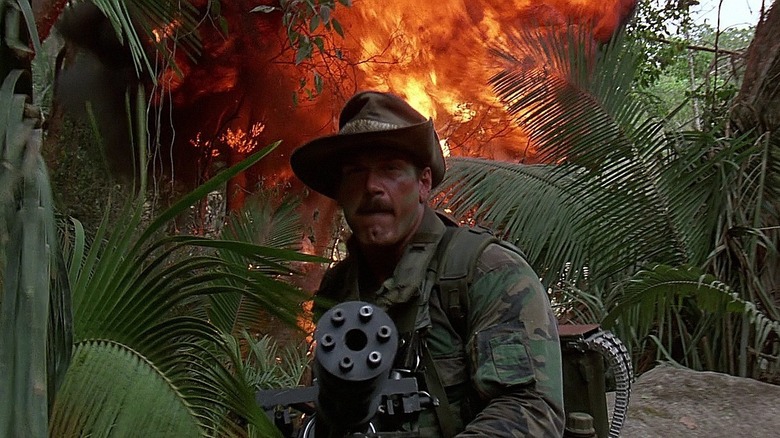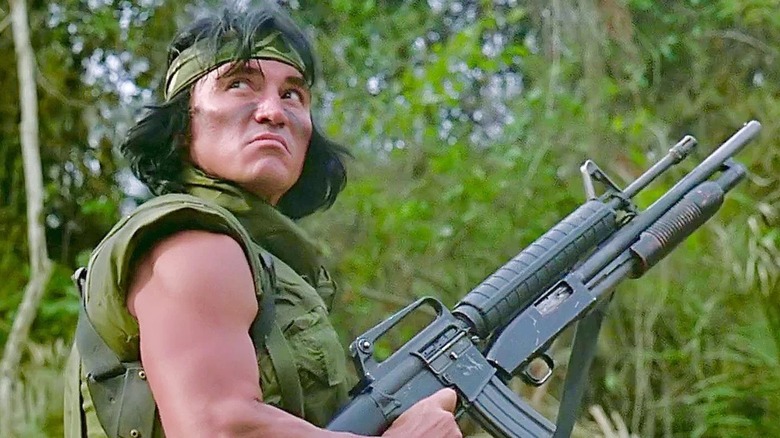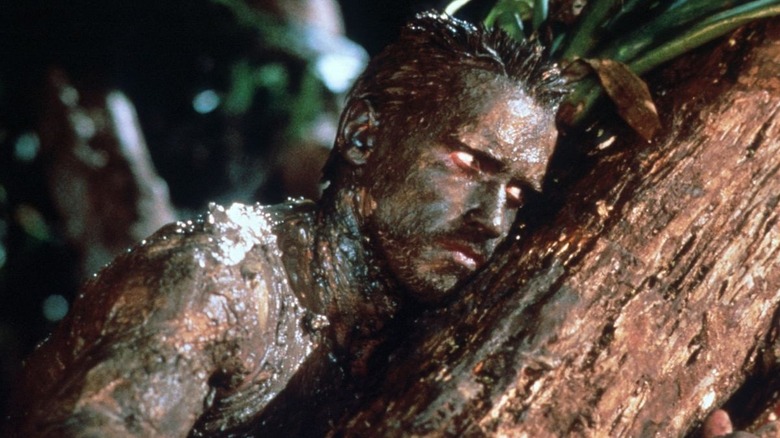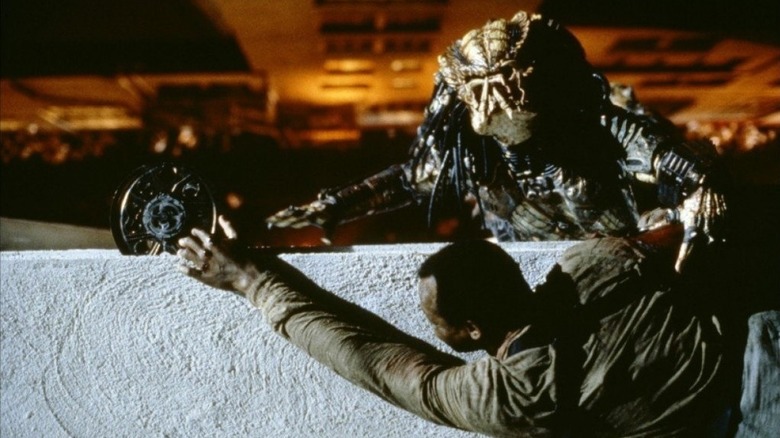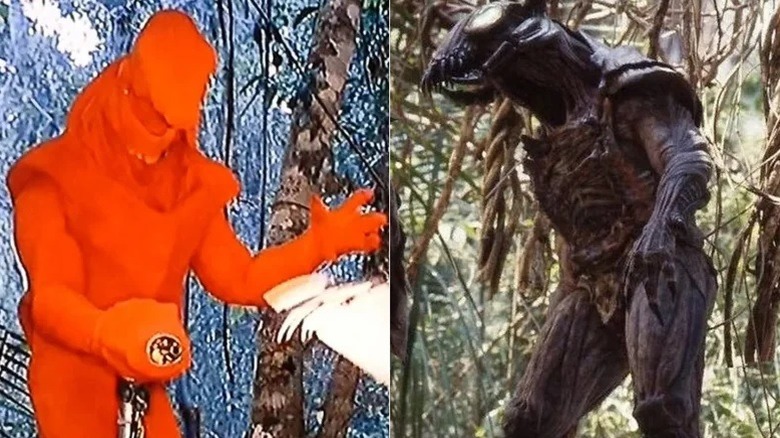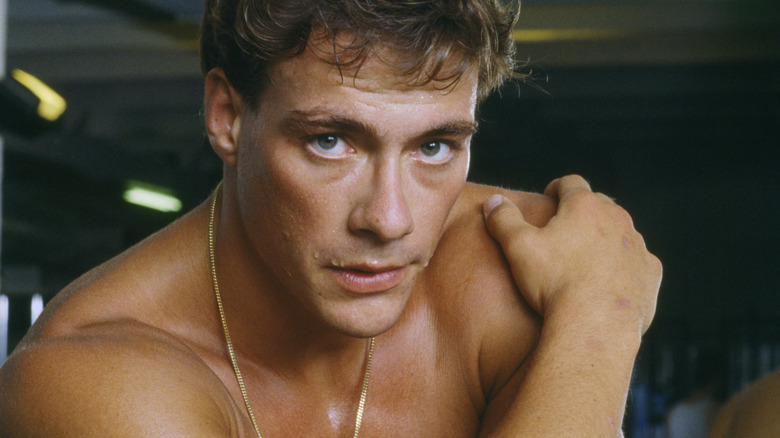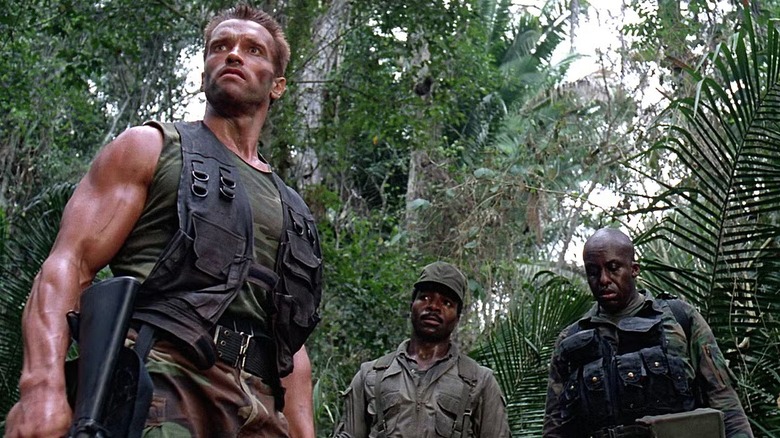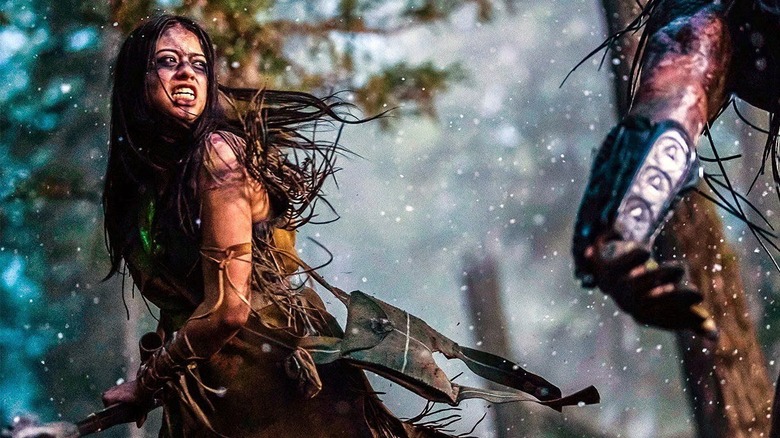False Facts About The Predator That Everyone Believes
When it comes to the movies, the "Predator" franchise is big on action and pretty light on lore. Fans of the "Predator" comics might call the race of creatures Yautja and have an idea of what their homeworld is like, but for people who just follow the movies, all that really matters is that they're alien hunters who love killing humans and generally have an easy time doing so thanks to their cloaking technology and thermal vision.
So in the absence of lore in the movies, it's all too easy to make big assumptions about how it all works. In time, with the aid of the internet, those assumptions become accepted as facts, regardless of how little bearing they have on the movie canon. So let's correct the record. From the alien's true nature to the future of the franchise, here are facts about the "Predator" series that aren't really facts at all — they're just incorrect assumptions that a lot of fans continue to believe.
The Predator is a predator
To begin with, one thing to know about Predators is that they're not really predators. It sounds confusing, but it's true. It's even pointed out directly by the biologist Casey Bracket (Olivia Munn) in "The Predator." After all, while "Predator" is a great name for a movie about an alien who comes to Earth just to kill people, that doesn't mean it's technically accurate as a label for the creature.
In the natural world, a predator is a creature that kills another organism for food. That last bit is important. Predators (as in actual Earth animals in nature) kill because they need to eat. In contrast, the Predators who appear in the sci-fi franchise of the same name kill for sport or to prove their own prowess as hunters. The Yautja don't eat their kills — they just skin them, hang them upside down, and sometimes remove their skulls and spines to wave around triumphantly. They don't want meat; they want trophies. By definition, they're not predators.
There's one Predator who's come back to Earth multiple times
If you haven't seen the "Predator" movies — or if you just haven't paid that much attention — it makes sense to believe that there's one primary Predator throughout the franchise. After all, the titles for every film except one (2010's "Predators") are singular. There's a Predator who keeps coming back for more. Of course, none of that is true.
The main Predator (when there is just one) dies in literally every movie. The title creature of 1987's "Predator" blows himself up with a self-destruct device after being grievously wounded by muscle-bound mercenary Dutch Schaefer (Arnold Schwarzenegger). The urban hunter of 1990's "Predator 2" is killed in battle with LAPD cop Mike Harrigan (Danny Glover). All of the Predators in "Predators" are taken down by their intended prey, although the ending points to more aliens arriving soon. The oversized, genetically-hybridized creature at the center of 2018's "The Predator" is taken down by that movie's central characters, and Native American warrior in training Naru kills her Predator with its own tech in 2022's "Prey."
The thing about Predators, of course, is that there are always more of them. Furthermore, it's pretty clear at this point that hunting humans (presumably alongside other sentient creatures from around the galaxy) is a cherished tradition on their planet, so they're just going to keep doing it, no matter how many die trying.
They see in infrared
Particularly with the first and most beloved film in the series, some of the franchise's most iconic imagery comes from the Predator's point of view, showing Arnold Schwarzenegger and other cast members in bright colors that represent the intensity of their body heat as the creature hunts them through the dense jungle. This has led some viewers to mistakenly think that the Predator species has actually evolved to see with thermal imaging. If you pay attention, however, it becomes pretty clear that this infrared imaging is technological and contained in the lenses of the Predators' masks.
In "Predator 2," the extraterrestrial hunter has multiple vision modes he can switch between. And while we never see that happen in the original film, it's hard to deny that the otherworldly villain here must have other forms of vision as well. For example, how could he so easily avoid all the traps set for him by the commandos if all he can see is heat (which those traps wouldn't give off)? Plus, in the fantastic scene where he first takes his mask off, we watch as his vision completely changes, with the infrared disappearing from sight.
The franchise has been rebooted
It's not just the Predators who die and are replaced for every movie. Of all the "Predator" films released to date (counting the two "Alien vs. Predator" movies, which maybe we shouldn't, but we'll get to that), not a single installment features a returning human character from a previous movie. After almost four decades of that same formula, it starts to look like none of the movies are really connected at all. The two installments from the 2010s in particular seem to bear the hallmarks of franchise reboots. "Predators" moves the action from Earth to an alien planet, while "The Predator" has a new military-based story and a title distinguished from the first movie only by the article "the." They appear to be reboots to those with only a passing interest, but, of course, this isn't the case for either flick.
Setting aside the more complicated "AVP" installments, each "Predator" movie establishes that the previous films did indeed happen, even if the events have been classified so that most people don't know about them. In "Predator 2," government agent Peter Keyes (Gary Busey) discusses the events of the first movie. In "Predators," the character of Isabelle (Alice Braga) recognizes the Predators from a description of the events of the original "Predator." In "The Predator," the events of the first two movies are discussed and further confirmed as real by the presence of Sean Keyes, the son of Peter Keyes from "Predator 2," who's played by Gary Busey's actual son, Jake Busey. And the credits of the prequel film "Prey" include ledger art paintings that predict the arrival of more Predators on Earth, tying it into the films that came before it.
They exist in the same universe as the Xenomorphs from Alien
Let's talk about those "Alien vs. Predator" movies. The first "AVP" flick came out in 2004, and it was followed by "Alien vs. Predator: Requiem" in 2007. While the 2004 film took place in a secret compound in Antarctica where the Predators hunt Xenomorphs in a controlled environment (of course, things fall apart over the course of the movie), "Requiem" featured Predators hunting an escaped hybrid "Predalien" and several Xenomorphs through a small Colorado town. Both films feature hints at the future of the "Alien" movies, with the second one in particular showing a left-behind piece of Predator technology falling into the hands of the Yutani Corporation. This will one day be a part of the all-encompassing Weyland-Yutani, a company that hangs over the entire "Alien" movie saga.
According to the directors of "Alien vs. Predator: Requiem," the plan was to use a third movie to tie the events of the "AVP" movies directly into the original "Alien," bringing things full circle as Weyland-Yutani use Predator technology to develop the means of space travel that leads to the existence of ships like the Nostromo, which then encounters the Xenomorph in "Alien." That plan changed when original "Alien" director, Ridley Scott, returned to the franchise. He made his own prequel, "Prometheus," which led directly into "Alien: Covenant." These films are completely separate from the "AVP" history, with no signs that either the development of Weyland-Yutani or humanity's history with extraterrestrial beings resemble anything from those films. So, whatever the case might be with the somewhat looser "Predator" continuity, it's very clear at this point that the Xenomorphs of the "Alien" films exist in a different timeline from any Predator.
Predator 2 is a terrible movie
Few sequels are as commonly maligned as "Predator 2." It came in fourth at the box office on its opening weekend, was critically panned, and later installments in the franchise were celebrated for ignoring it. It's not a classic like its predecessor, and there's a good chance you haven't even seen it. If that's the case, go watch "Predator 2" and decide for yourself ... because it actually has a lot going for it.
It's a clear and deliberate departure from the first movie, but that's a better choice than trying to duplicate the original. "Predator" had jungle action pretty well-covered, so "Predator 2" brought its titular alien hunter to the streets of downtown Los Angeles. What's more, it's a near-future Los Angeles (the movie came out in 1990 but takes place in 1997), in which gangs rule the city, cops barely stand a chance, and everybody's guns still shoot bullets but they're weirdly big and chunky-looking. The aforementioned Danny Glover is the hero, as different from Arnold Schwarzenegger as an action star could be. Bill Paxton is also there, bringing the same big weird energy he had in "Aliens" to the role of a sleazy but ultimately heroic cop in Glover's squad.
Some of the depictions of people of color haven't aged very well, but that's true of most action movies of this era, and at least this one has a badass Black hero. In fact, it's ultimately Danny Glover's performance as a detective who simply won't quit no matter what he's up against that makes "Predator 2" something of an underrated gem. Watching it back today makes you realize how much of a shame it is that we don't really hear from Danny Glover anymore.
Predators don't kill women
In "Predator," the captured rebel Anna (Elpidia Carrillo) is the only survivor besides Schwarzenegger's Dutch. In "Predator 2," the hunter corners Detective Leona Cantrell (Maria Conchita Alonso) and then decides not to kill her. It also spares Ramon Vega's mistress Mary (Teri Weigel) during a massacre in the drug lord's penthouse. In "Alien vs. Predator," the central Predator actually befriends Lex Woods (Sanaa Lathan) and works with her to defeat the aliens. Isabelle (Alice Braga) survives "Predators," and Casey Bracket (Olivia Munn) survives "The Predator." So what's the deal? Do Predators not kill women?
Predators don't necessarily care about gender. They just don't kill unarmed people, which is why Dutch discourages Anna from picking up a gun in "Predator," thus saving her life. It also seems that they don't kill pregnant people, which is why Detective Cantrell is spared. The drug lord's girlfriend also falls under the unarmed rule. As for Isabelle and Casey (and Lex for that matter), they're exciting female action heroes in those movies, and it would've been a bummer for audiences to see them slaughtered.
Anna and Isabelle are literally the only female characters in their respective films, and Cantrell is just about the only woman in "Predator 2" who's not a drug lord's naked girlfriend. So killing them would've just seemed really dark. At the end of the day, what keeps the Predators from killing women is the narrative choices of these movies, not any code the species has. The arrival of Amber Midthunder's badass female protagonist Naru in 2022's "Prey" put to bed this notion that Predators don't kill women — or try to kill women, in Naru's case.
Predators need their masks to breathe on Earth
As part of the gadget-filled techno-armor they prefer to wear when hunting humans, each Predator has a metal face mask that they generally don't lose until the final showdown, when it's time to give the heroes and the audience a good look at that creepy, mandibled face. Because Predators show up to Earth wearing this mask and don't usually take it off until shortly before they die, a lot of people assume that the mask is what enables them to breathe in Earth's atmosphere. If you pay attention, however, that's clearly not the case.
The first Predator does without a mask for a long time while fighting Dutch in the jungle, and he seems to breathe just fine. In "Predator 2," the creature is seen breathing through another device after losing his mask, but we don't know exactly why. Maybe the L.A. smog is too much for him. This same movie establishes that Predators breathe the same air as humans, however, because Harrigan can breathe inside their spaceship, even when interacting with an unmasked extraterrestrial. The same thing is true of the alien planet in "Predators" — the humans can breathe there just fine, and so can the unmasked hunters.
There's no doubt the mask provides copious tools to aid a Predator's survival — starting with that famous thermal vision — but a breathing apparatus is not one of them.
Predators all follow the same code of conduct
Most Predators seem to hunt by a code of honor: Don't kill anyone who's unarmed or pregnant, and respect your opponent. Those ideas are important to the first two "Predator" movies and even to the "Alien vs. Predator" films. In the two installments from the 2010s, however, some new breeds of Predators show up, and they're just big mean jerks.
"Predators" features bigger, meaner Predators who are implied to be a different clan from the ones we've met before. They even have a "classic" Predator tied up in their camp to drive home the contrast. These extra-large Predators are still looking for a good hunt, but they don't seem to care about who's armed or anything like that. They'll kill you no matter what you're up to.
The first beast to show up in "The Predator," meanwhile, is a classic model, but he's quickly hunted down and killed by a bigger, more powerful Predator. Unrelated to the bigger clan from "Predators," this creature has gained his power from hybridizing his own DNA to incorporate other species' powers and abilities. He also doesn't seem to care about rules. He just wants to kill and, in time, to conquer.
The Predators are a noble warrior race
It's easy to see why some "Predator" fans might see the Yautja as a noble warrior species not unlike the Klingons of the "Star Trek" universe based on the fact that they seem to disregard prey that can't defend themselves. An example of this can be seen in "Predator 2" when the City Hunter scans a child, ultimately letting him go after identifying the potential prey's weapon as just a toy. Similarly, the City Hunter also rejects LAPD officer Leona Cantrell (Maria Conchita Alonso) as potential prey after determining that she is pregnant.
However, this doesn't necessarily mean they're honorable. As many viewers have pointed out in "Predator" fan forums, Yautja seem to be in it for the sport and have more in common with human big game hunters than Klingons. And, like big game trophy hunters, they prefer to feel like they're being challenged while still gaming the system with their superior Predator weapons tech and camouflage. As Redditor u/jonnyeyeball pointed out after watching "Prey" six times, "the Yautja spent most of the movie cloaked. Now, I understand dramatic effect and all that, but against 18th century natives with zero chace to track him cloaked? Seems like god mode to me."
The Predators are all males
All Yautja in the "Predator" series have a similar look, and newcomers to the franchise tend to see this look as masculine coded. Since we're dealing with an alien race, there's no reason to assume that they conform to the same reproduction patterns as humans. However, according to the expanded Yautja canon outlined in the "Predator" books, comics, and video games, there are indeed male and female Predators, and they reproduce in a similar fashion, with the so-called "spawnlings" being born just like mammals are on Earth. The existence of female Yautja is explicitly mentioned in the 2020 game "Predator: Hunting Grounds" by "Predator" protagonist Dutch Schaefer (reprised by Arnold Schwarzenegger, who didn't return for "Predator 2").
Discussing the female Predator known as Cleopatra, Dutch says: "We weren't certain if they had any gender to speak of, but that changed when we came in contact with the female. She was smarter and deadlier ... She was direct, ruthless, and skilled." While female depictions are inconsistent in Predator lore, they do tend to be depicted with physical differences from the male Yautja, typically having smaller eyes and heads that are more narrow. Other examples of females Predators include Big Mama from the comic book "Aliens vs. Predator: Deadliest of the Species," Sister Midnight from the "Witchblade/Aliens/Darkness/Predator: Mindhunter" crossover comic, and Vagouti from the "Predator: If It Bleeds" anthology book story "Rematch."
Predator is war propaganda
With its massive guns and even bigger soldiers, it's not hard to see why some people might mistake the first "Predator" film as pro-U.S. military propaganda, especially as it came out toward the very tail end of the Cold War, just two years before the Berlin Wall fell. It's an idea that's been explored by cultural critic and writer Alex Adams, who posits that "Predator" is "tethered very directly to its specifically nuclear context. In the film's closing moments, the predator initiates a colossal explosion, a mushroom cloud pinpointing the site of its demise. Knowing that Dutch has defeated it, the beast detonates himself, cackling a monstrously polyvocal laugh. This is a clear invocation of the political fear that "savages" will gain nuclear weapons, and that they will be self-destructively insane—or simply spitefully reckless—enough to actually use them."
However, while it's more than possible that "Predator" inspired a military interest in a handful of G.I. Joe-loving Gen-X boys, many now look back on the first film in the franchise as a tale about the futility of war rather than a soft propaganda flick. This is a theme explored in several movies about the Vietnam War, which "Predator" seems to mimic, right down to the idea of an invisible enemy lurking in the jungle. It's true that Dutch embodies the spirit of an idealized American soldier with his resilience in the face of seemingly insurmountable odds, but his brothers in arms have been wiped out by the end of the film and he emerges not heroically, but by the skin of his teeth, undermining any patriotic subtext. If anything, the film tells us that nobody wins in war.
One of the Predator's kills was so violent it got cut from the film
One of the wildest myths in "Predator" fandom is that a death scene in the first film was so brutally graphic it had to be cut. The rumor revolves around the demise of Billy (Sonny Landham), the half-Native American, half-Italian tracker who is shown preparing to face off against the Predator by brandishing his machete. In the final cut, Billy's death occurs off-screen, and viewers are never given the opportunity to see his last valiant battle against the alien foe. But was it ever filmed? Billy's death was described in the novelization of the film, but, according to Landham himself, they never planned on filming it: His death was always going to happen off screen.
In the final cut, we are left to assume that he's been killed when we hear his cries of pain, but Landham revealed that his fate was originally supposed to be confirmed in the finale. The late actor went into detail about the original plan for his character during a 2013 interview with the website The Arnold Fans. "With my death, you did hear me scream and then later you see my skull and backbone jerked out up in the tree. Well, what was supposed to happen was Arnold was supposed to find the spaceship, and blow the spaceship where the Predator went back to regain life, where his life-system was," Landham said. "But they blew the money for the spaceship and you were going to see all of these trophies from all over the universe."
The Jungle Hunter was bested by a human
There's no denying that Dutch is an absolute warrior in the first "Predator" film. But look a little closer and you'll see it was pure luck, not Arnie's beast mode, that was responsible for the Jungle Hunter's demise. As some viewers have pointed out, it's easy to paint Dutch's victory as a hardcore human soldier outwitting a Yautja with his tactical and physical prowess. Though, realistically, Dutch was physically outmatched in this fight, and the seemingly clever plan that led to his victory was nothing short of a huge Hail Mary.
It's true that Dutch's plan to hide his body heat in mud was a stroke of genius that bought the soldier time to mount his final offensive, beginning with a bonfire to lure the Yautja. It starts off strong with Dutch managing to disable the Predator's camouflage. However, his plan leaves him without ammo, and Dutch's final play to lure the Predator into a spike trap fails when the Yautja gets wise. Luckily for Dutch, his foe walks directly under the trap's counterweight, which the human then uses to crush the hunter. As Redditor u/AndoionLB wrote, "Dutch just got extremely lucky."
The City Hunter is a weak Predator
Some fans have cited the fact that Lieutenant Mike Harrigan (Danny Glover) was able to defeat the City Hunter in "Predator 2" as evidence that the second Yautja to be shown on the big screen is weak. In fact, there's a widespread belief that the Predators actually get weaker with each passing sequel. After all, the Jungle Hunter had waged a brutal war against Dutch, Colonel Al Dillon (Carl Weathers), and a full paramilitary team. How, then, could a City Hunter worth his salt be defeated by a city cop in his mid-forties?
The truth is that the City Hunter's defeat is a death-by-a-thousand-cuts scenario, with the alien warrior severely weakened by the showdown. "I never want to hear 'Pred got killed by a middle aged cop' when the fight was basically a Pred that was severely injured with a hand tied behind his back vs a cop with preparation and an arsenal of weapons," complained Redditor u/ApexRathalos038, adding, "Harrigan would have been dead 10x over if any scenario in the freezer played out." Like Dutch's victory in the first film, Harrigan's success was more to do with luck than his enemy not being up to the task of taking down a human.
The Predator has always looked the same
Somewhere in an alternate universe, there's a version of "Predator" in which the titular alien is a goofy-looking monster straight from a B-movie — and is played by none other than Jean-Claude Van Damme. The original Predator suit, which was designed by makeup and prosthetics veteran Steve Johnson of Boss Film Creature Shop, is the stuff of legend. The concept had been given to Johnson in a Hollywood board meeting with director John McTiernan and a handful of executives. McTiernan came into the meeting with a collection of sketches from a production designer, which Johnson would later describe as "awful" in an appearance on "The Monster Show."
Execs wanted the Predator to have an ant-like head, backward-bending reptile legs, and elongated arms complete with three-fingered hands. The problem was that no one had really factored in just how poorly this concept would fare on the muddy slopes of the Mexican jungle. "It was virtually physically impossible to do," Johnson told "The Monster Show," noting that he warned the big wigs of this before he made the suit. When things didn't work out with the first design — which also included an all-red, VFX-friendly cloth version specifically designed for the scenes in which the Predator uses his cloaking device — the original suit was scrapped and Stan Winston's creature studio was brought in to start from scratch. The result was the iconic design that fans know and love.
Jean-Claude Van Damme was fired for being too short
For decades, a rumor has circulated that Jean-Claude Van Damme was fired from "Predator" for being too short for the first Yautja suit. At just under 5'10” tall, the Belgian martial artist isn't exactly a small man. The truth is that any actor would have struggled to perform in the original Predator costume, no matter their height. These rumors likely stem from the fact that Van Damme was replaced with 7'4” actor Kevin Peter Hall, but, by this point, the man known as "The Muscles from Brussels" had already been let go. Accounts vary over the exact moment that Van Damme was fired, but most have one thing in common — he clashed with the filmmakers over the look of the alien and the fact that he wasn't allowed to do any martial arts.
Van Damme reportedly kept trying to incorporate kicks into his Predator portrayal, which, according to special effects supervisor Joel Hynek, led to a confrontation with producer Joel Silver. "I was in Joel Silver's trailer, and he had called for Jean-Claude to come see him," Hynek told The Hollywood Reporter. "He was telling him, 'Look, the Predator is not a kickboxer.' And Van Damme was like, 'I must do that; that's how I see the Predator.' And Joel said, 'Well, you're fired. Get out of here.'" Van Damme then told Silver to kiss a certain part of his body and walked out, Hynek added.
Other people who worked on the film have come forward with their own recollection of the moment Van Damme was canned. Second unit director/stunt coordinator Craig Baxley claims that Van Damme smashed the head of the original Predator outfit (which was worth $20,000) in frustration, which apparently prompted Silver to tell him that he would "never work in Hollywood again." Bill Duke, who played Mac, says Van Damme was fired because he couldn't stop passing out from the heat, which began to frustrate producers. There are at least six conflicting accounts of Van Damme's firing, so the exact truth will likely never be known.
Somebody was seriously injured on the Predator set
In 2019, Jean-Claude Van Damme fed the "Predator" rumor mill by launching a new claim in an interview with The Hollywood Reporter: The man who was originally hired to play the Predator told the outlet that someone had been seriously injured on the set. According to Van Damme, the incident occurred when someone else was brought in to perform a stunt that he had refused to do. The Belgian martial artist said that he knew the jump he was being asked to perform was too dangerous, and that he relayed this to producer Joel Silver. He said: "When Joel asked me to jump, I knew it was gonna be a bad one. I said, 'This is impossible, Joel. I think we're gonna have a problem.'"
According to Van Damme, his refusal to perform this particular stunt is what actually led to him getting his marching orders. But, the way he remembers it, he was proven right. "The guy who did my stunt, something bad happened to him," Van Damme said, making a snapping motion with his hands. "Crack. And then they stopped the film, and they did a new, more safe outfit." This was strenuously denied by stunt coordinator Craig Baxley, who said, "Nobody was ever hurt," as well as first assistant director Beau Marks.
We've seen the last of the Predator
Released in 2018, "The Predator" was only a middling success at the box office, and it was widely panned by critics and audiences alike. For a while, it seemed like the film had killed off the franchise, but then news of an upcoming prequel broke. People were understandably skeptical given how underwhelming "The Predator" was, but 2022's "Prey" turned out to be a totally different experience — in fact, with a Certified Fresh score of 94% on Rotten Tomatoes, it's the best-reviewed entry in the "Predator" franchise by some distance.
"Prey" is set in 1719 and tells the story of Naru (Amber Midthunder), a young Comanche healer who wants to prove herself as a hunter. She tries to warn her tribe about an unexplained threat nearby after coming across a skinned rattlesnake and some unusual tracks, but nobody believes her. Looking to prove herself, she heads out to investigate — and ends up coming face to face with a Predator. She ultimately earns the title of War Chief after killing the alien hunter, but the film's credits warn of the arrival of more Predators.
"Prey" was a record-breaking hit for Hulu, becoming the most-watched release on the platform ever across its first three days. It took a while for a follow-up to be confirmed, leading fans to ask if "Prey 2" would ever actually happen, but it was greenlit in 2024. What's more, there's a further two "Predator" films from "Prey" helmer Dan Trachtenberg slated to drop in 2025: The animated anthology movie "Predator: Killer of Killers," which is coming to Hulu in June, and "Predator: Badlands," which will star Elle Fanning and Dimitrius Schuster-Koloamatangi and is set for a theatrical release in November.
